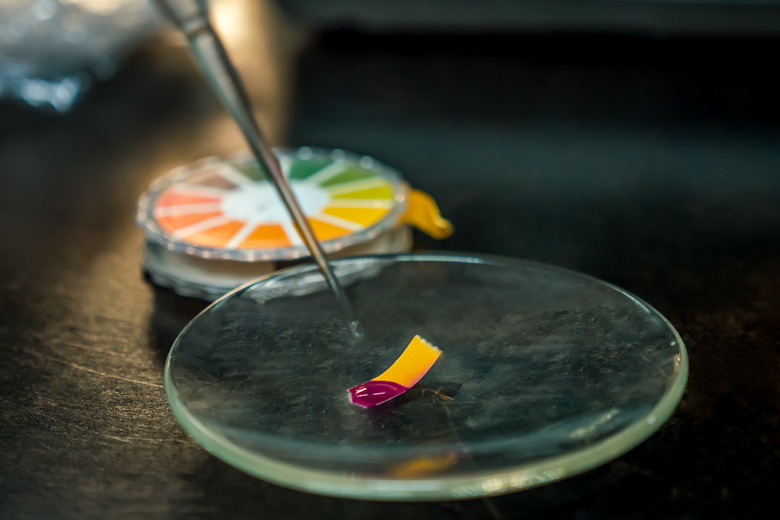What Substances Turn Red Litmus Paper Blue?
The simplest way to establish the pH of a substance – to figure out whether it is acidic or alkaline – is to use red and blue litmus papers. Red litmus paper reacts to alkaline substances by turning blue, while blue litmus paper reacts to acidic substances by turning red.
TL;DR (Too Long; Didn't Read)
When red litmus paper comes into contact with any alkaline substance, it turns blue. Some examples of alkaline substances are ammonia gas, milk of magnesia, baking soda and limewater.
Red Litmus Paper Properties
Red Litmus Paper Properties
Litmus paper is made from wood cellulose that is infused with an aqueous solution consisting primarily of lichens. During the production of red litmus paper, the lichens are left to ferment in potassium carbonate, ammonia, and a small amount of sulfuric or hydrochloric acid. The mass is then mixed with chalk. It is this solution that makes the paper pH active. White paper is impregnated with the solution and left to dry in open air. The process for blue litmus paper is similar, but no sulfuric or hydrochloric acid is added to the solution.
Alkaline Substance Examples
Alkaline Substance Examples
The pH scale ranges from zero to 14, with a pH of 7 being neutral, a pH less than 7 being acidic, and a pH greater than 7 being alkaline. Ammonia gas turns red litmus paper blue because it has a pH of 11.6. Milk of magnesia is slightly less alkaline, with a pH level of around 10.5. Sodium bicarbonate, otherwise known as baking soda, has a lower pH level still, at around 8.4, but it is still alkaline because it is above the neutral pH value of 7. Other examples of substances that turn red litmus paper blue include sodium hydroxide (caustic soda), calcium hydroxide (limewater) and alkaline soils.
Using Red Litmus Paper
Using Red Litmus Paper
Red litmus paper is dipped into a solution to establish whether a substance is acidic or alkaline. In an acidic or neutral solution, red litmus paper remains red. In an alkaline solution, red litmus paper turns blue. When an alkaline compound dissolves in water, it produces hydroxide ions, which cause the solution to become alkaline. Red litmus paper can also be used to test the pH of a water-soluble gas by dampening the paper and exposing it to the gas.
Red Litmus Paper Limitations
Red Litmus Paper Limitations
While red and blue litmus papers can reveal whether a substance is acidic or alkaline, they cannot tell you the exact pH value of that substance. However, litmus papers are easy to handle and use. They give instantaneous readings and provide accurate results most of the time.
Cite This Article
MLA
Gillespie, Claire. "What Substances Turn Red Litmus Paper Blue?" sciencing.com, https://www.sciencing.com/substances-red-litmus-paper-blue-5503464/. 11 April 2018.
APA
Gillespie, Claire. (2018, April 11). What Substances Turn Red Litmus Paper Blue?. sciencing.com. Retrieved from https://www.sciencing.com/substances-red-litmus-paper-blue-5503464/
Chicago
Gillespie, Claire. What Substances Turn Red Litmus Paper Blue? last modified March 24, 2022. https://www.sciencing.com/substances-red-litmus-paper-blue-5503464/
